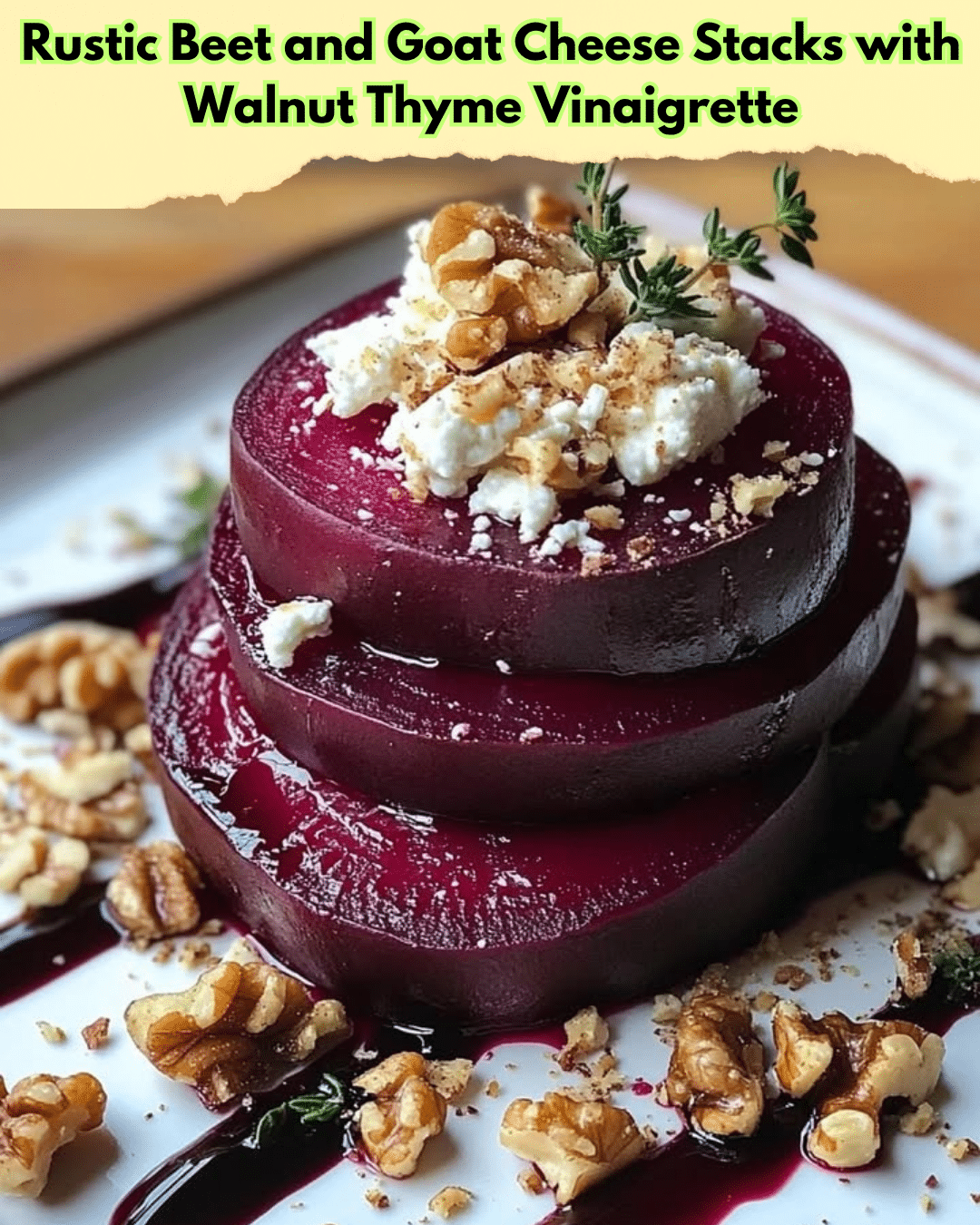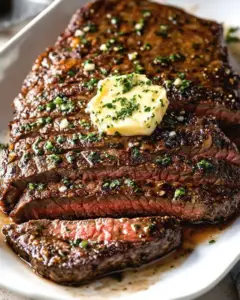Rustic Beet and Goat Cheese Stacks with Walnut Thyme Vinaigrette: Elevate Your Table with Nature’s Bounty
Rustic Beet and Goat Cheese Stacks with Walnut Thyme Vinaigrette is a sumptuous celebration of earth’s vibrant bounty. The recipe marries tender, roasted beets with creamy goat cheese, all drizzled with a nutty walnut thyme vinaigrette that will awaken your palate. This exquisite dish is perfect for a refined dinner party or an indulgent lunch, offering layers of rich flavors and textures. As you savor each bite, you’ll appreciate how the beets’ mild sweetness complements the tangy cheese and savory dressing, creating a harmonious symphony of tastes.
Beets have always been an unsung hero in the vegetable world, and in this recipe, they truly shine. Known for their beautiful, deep crimson color, beets provide not only vibrant hues but also earthiness and sweetness, offering a complex taste profile that’s both unique and comforting. When paired with goat cheese, the resultant éclat makes every forkful feel like a gourmet experience. Meanwhile, the walnut thyme vinaigrette adds a sophisticated finish, enhancing the dish with its nutty, herbal notes.
Quick Recipe Highlights
- Flavor Profile: The interplay of sweet beets, tangy goat cheese, and nutty vinaigrette provides a melodic taste experience.
- Texture: Smooth goat cheese complements the tender beets, while crunchy walnuts add a pleasing contrast.
- Aroma: The thyme-infused vinaigrette imparts an irresistible savory scent.
- Visual Appeal: The radiant colors and elegant presentation of stacked layers are visually striking.
- Skill Level Needed: Requires intermediate kitchen skills for roasting and assembling.
- Special Equipment: Mandoline slicer for uniform beet slices, whisk or blender for vinaigrette.
Recipe Overview
- Difficulty Level: This recipe is moderately challenging, requiring precision in slicing beets and careful attention to the balance of flavors in the vinaigrette.
- Category: Perfect as an appetizer or a light main course, fitting for formal meal settings or casual gatherings.
- Cuisine: Hints of French cuisine influence the elegant preparation and ingredient pairing.
- Cost: Primarily inexpensive, with beets and walnuts being cost-effective; goat cheese may vary by brand.
- Season: Best enjoyed in fall or winter, when beets are harvest-fresh and add warmth to the table.
- Occasion: Suitable for festive gatherings, celebratory dinners, or intimate brunches.
Why You’ll Love This Recipe
Rustic Beet and Goat Cheese Stacks with Walnut Thyme Vinaigrette brims with culinary appeal, from the first glance to the last bite. Be prepared to be mesmerized by the taste journey this dish offers: the roasted beets, softened to perfect tenderness, yield a gentle sweetness offset by the tartness of creamy goat cheese. Walnut thyme vinaigrette adds depth with its savory blend, balancing the dish magnificently. The textures are an artful medley, satisfying with each mouthful of velvety goat cheese, tender beets, and crisp walnuts.
Preparation is straightforward, yet yields a dish that appears both refined and gourmet. The recipe benefits from convenience—the beets can be roasted in advance, simplifying the final assembly. Be assured of the nutritional value; beets are rich in vitamins and minerals, while the presence of healthful fats in the walnuts brings added nourishment.
Equally at home during grand celebrations or informal dining, the elegant presentation elevates any event, captivating guests with its grace and charm. Beyond its aesthetic allure, the dish is budget-friendly, juxtaposing everyday ingredients into a luxurious experience. These beet stacks with goat cheese offer not just a meal, but an occasion—a culinary event to remember and savor.
Historical Background and Cultural Significance
The origins of dishes like the Rustic Beet and Goat Cheese Stacks find their roots intertwined with culinary traditions that value locally-sourced, fresh ingredients. Historically, beets have been a staple in European and Mediterranean diets, cherished for their hardiness and versatility. In particular, French cuisine has celebrated the combination of beets and goat cheese, often seen in vibrant, fresh salads meant to tantalize both eye and palate.
As culinary traditions spread and evolved, this dish has been embraced for its ability to highlight natural flavors and compliment them with minimal intervention. It’s a testament to the adaptability of ingredients like beets, which through centuries have served as essential nourishment. Goat cheese, with its historical prominence in French and Mediterranean cooking, provides a creamy counterpoint that echoes rustic pastoral roots.
The evolution of this recipe mirrors a growing appreciation for dishes that emphasize freshness and flavor depth. Regional variations have introduced new elements and flavors: from honey-drizzles in Eastern Europe to citrus-kissed vinaigrettes in the Mediterranean. Each adaptation reflects local palates, yet honors the deep-seated love for simplicity and robust taste.
Ingredient Deep Dive
Beets are the colorful heart of this recipe, known for their stunning hue and naturally sweet flavor. Historically, they were cultivated for their medicinal properties, but soon became part of the culinary world, appreciated across many cultures. Nutritionally, beets boast high levels of fiber, essential vitamins like folate and Vitamin C, and unique antioxidants. When selecting beets, choose firm, deep-colored ones for the best flavor. Store them in a cool, dry place, ensuring lasting freshness. Substitutions such as golden beets offer a milder taste and an equally appealing color contrast.
Goat cheese, essential to this dish, brings rich, tangy notes that complement the sweetness of the beets. It has been produced for thousands of years, particularly in Mediterranean cultures, where its creamy texture and distinctive flavor profile make it a culinary favorite. Goat cheese is low in lactose, making it suitable for many lactose-intolerant diets. It should be stored in the refrigerator, tightly wrapped to maintain its texture and flavor. Alternatives like feta can be used for varied taste profiles, offering similar tangy undertones.
Common Mistakes to Avoid
- Over-roasting the beets, which can make them too soft and lose flavor intensity. Aim for fork-tender doneness.
- Using low-quality goat cheese, which can alter the texture and taste. Opt for fresh, tangy varieties.
- Not balancing the vinaigrette well—ensure the acidity, sweetness, and oil are harmoniously mixed.
- Skipping the resting time for roasted beets before stacking, which can lead to excess moisture and soggy layers.
- Failing to toast walnuts properly, resulting in a lackluster crunch; a light toasting heightens aroma and flavor.
- Inadequate seasoning, which can make the dish taste flat; balance seasoning with all key ingredients.
- Neglecting presentation—take care to slice beets uniformly for an attractive stack.
- Using excessive vinaigrette, drowning the delicate flavors rather than enhancing them.
Essential Techniques
Roasting the Beets: This foundational step infuses the beets with sweetness and tenderizes their texture. Mastering roasting involves ensuring consistent heat to achieve even cooking through all beets. A visual cue of readiness is when a fork can easily pierce the beets without them falling apart. Be wary of over-roasting; it’s important that the beets retain some firmness for stacking integrity.
Crafting the Walnut Thyme Vinaigrette: Achieving the perfect vinaigrette means balancing flavors—it’s a play of acidity from vinegar and the robustness of walnut oil. Keep the components distinct but harmonized; the fragrance of thyme should whisper, not shout. When blended well, you’ll notice a silky, cohesive texture that clings lightly to beets and cheese.
Pro Tips for Perfect Rustic Beet and Goat Cheese Stacks
Ensure beets are completely cooled before assembling to prevent cheese melting and stack collapse. Aim for uniform beet slices for stability, using a mandoline slicer for precision. Toast walnuts just before use to capture their peak aroma and crunch. Allow the vinaigrette to rest after mixing, encouraging flavors to meld. Plate the final dish on contrasting plates to enhance visual allure. Serve immediately after assembly for optimal texture experience. Opt for fresh thyme over dried, as it maintains vibrant flavors in the vinaigrette.
Variations and Adaptations
Regional variations abound with these beet stacks. In Italy, a hint of balsamic reduction might be added to the vinaigrette, adding sweetness and depth. For a vegan adaptation, replace goat cheese with a smooth cashew cheese alternative, offering a nutty note. Seasonal fruits like pears or citrus can be layered for added freshness depending on the time of year, enlivening the palate with new dimensions. Texturally, consider a dusting of candied pecans for added sweetness and crunch.
Serving and Presentation Guide
Present each stack meticulously on chilled plates, ensuring layers are visible to showcase the beet’s jewel tones contrasted against white goat cheese. Garnish with freshly sprigs of thyme and sprinkle with toasted walnuts for a rustic touch. Traditional accompaniments, such as a crusty baguette, enhance the richness of the cheese. Keep the temperature ambient to spotlight optimal flavor profiles. Portion with care, serving slightly smaller stacks to allow room for other meal courses.
Wine and Beverage Pairing
Pairing this dish includes fine choices such as a light, crisp Sauvignon Blanc that complements the earthy beets and tangy cheese. Consider non-alcoholic options like a ginger-infused sparkling water, which cleanses the palate between bites. Black tea might also pair well, adding a subtle, grounding tannin to balance the meal’s creamy aspect. Serving white wines slightly chilled enhances the tasting experience.
Storage and Shelf Life
Store assembled stacks only for short durations in the refrigerator to avoid wilting. Ideally, keep components separate: post-roasting, wrap beets in foil, and store cheese in airtight containers to maintain flavors and textures. Vinaigrette can be kept in a sealed jar for up to a week, shaken well before use. Watch for goat cheese becoming overly firm as a sign of aging. Avoid freezing assembled stacks, preserving ingredient integrity and flavor.
Make Ahead Strategies
Roast beets a day ahead, allowing plenty of time to cool beforehand, gradually enhancing their sweetness. Prepare the vinaigrette and chill, encouraging flavors to develop and blend. Simple assembly before serving ensures vibrancy and retains the dish’s integrity. For optimal results, include fresh thyme just before serving. Reheat nuts in a dry pan to renew crispness, ensuring a delightful crunch upon serving.
Scaling Instructions
For smaller gatherings, halve the quantity of beets and vinaigrette. Conversely, double or triple for large events, maintaining flavor ratios consistently. Larger volumes may necessitate more comprehensive tools like larger baking trays for beets or batch-blending vinaigrette. Be mindful of increased roasting times with additional beet quantities, assuring even cooking. Plan storage accordingly, particularly refrigeration space.
Nutritional Deep Dive
This dish is a powerhouse of vital macronutrients and micronutrients. Beets offer a wealth of folate and potassium, supporting cardiovascular health, while goat cheese provides a valuable protein source and essential fatty acids. Rich in antioxidants, walnuts enhance nutritional value with heart-friendly omega-3s. Each serving delivers balanced nutrition without overwhelming calorie content, making it suitable for a variety of diets, including those focused on maintaining healthy weights.
Dietary Adaptations
For gluten-free options, verify all prepared ingredients, particularly vinaigrette components. Dairy-free variations can employ vegan cheese substitutes with similar tanginess. The dish can turn keto-friendly by limiting beet quantity, focusing on cheese and walnut portions. Low-FODMAP adjustments involve reducing beet servings, maintaining digestive comfort without compromising taste.
Troubleshooting Guide
Achieving perfect doneness in roasted beets requires vigilance. Undercooked beets can dominate flavors, while overcooking results in mushy textures. Balance sweetness and acidity in the vinaigrette—separate and distinct is preferable to overly blended. Ensure smooth cheese spreads easily without clumping; improper handling can alter expert-layering processes. Watch temperature variations, which may distract from optimal texture presentation.
Recipe Success Stories
Encounters with this recipe often result in memorable dining experiences. Readers frequently mention profound flavor bonds created at their dining tables, sharing images that capture the sophistication and delight in serving this dish. Variations prove successful too, with humorous anecdotes of experimenting with diverse cheese types or infusions of regional flavor twists. Photography traded among enthusiasts reveals the artistry achieved with thoughtful ingredient alignment and eye-catching presentation.
Frequently Asked Questions
Can I use pre-packaged beetroot for convenience?
Yes, when short on time, pre-packaged beets offer a practical alternative, though ensure minimal additive content for best taste.
What alternatives can replace walnut oil?
For similar flavor profiles, you might substitute walnut oil with pecan or hazelnut oil. Olive oil offers a neutral base suitable for varied palates.
Can the dish be served warm?
While traditionally served cold or room temperature, warming is an option, though cheese softening should be managed to prevent excessive melting.
Are there substitutes for goat cheese?
Feta or a firm ricotta might replace goat cheese, offering comparable textures with unique tastes.
How do I prevent nuts from becoming soggy?
Store toasted nuts separately, adding to the plate just before serving to maintain optimal crunchiness.
What makes this dish suitable for entertaining?
The sophisticated layering, universal appeal of sweet-savory flavor combinations, and eye-catching presentation lend to any occasion’s charm.
Is raw thyme as effective as dried?
Fresh thyme brings a more pronounced aroma and flavor than dried, enhancing the overall taste experience when integrated into vinaigrette.
What should I serve alongside the stacks?
Consider light salads or crispy toasted breads, complementing the main flavors without overshadowing spectacular tastes.
Can the vinaigrette be made in advance?
Yes, prepare and store in the fridge for up to a week, allowing flavors to continue melding over time.
What’s the sustainable choice here?
Choose locally-sourced or organic produce to minimize environmental impact and increase support for local agriculture.
Additional Resources
For further exploration into ingredients, why not investigate similar dishes that spotlight other root vegetables or explore guides detailing vinaigrette mastery? Our library of related recipes juxtaposes these ingredients in many formats, available for adventurous culinary spirits seeking innovation. Uncover tips on the perfect goat cheese selection and usage within other culinary contexts, continuing your kitchen adventures via seasonal adaptations that promise renewal with each changing cycle.
Print
Rustic Beet and Goat Cheese Stacks with Walnut Thyme Vinaigrette
Description
A delightful combination of earthy beets and creamy goat cheese, topped with a flavorful walnut thyme vinaigrette.
Ingredients
For the Crust:
- 4 medium beets, cooked and sliced
- 8 ounces goat cheese
- 1/2 cup chopped walnuts
- 2 tablespoons fresh thyme leaves
- 3 tablespoons olive oil
Instructions
1. Prepare the Crust:
- Slice the cooked beets into even rounds.
- Layer beet slices and goat cheese to form stacks.
- In a small bowl, whisk together olive oil, chopped walnuts, and thyme to make the vinaigrette, then drizzle over stacks.
Notes
You can customize the seasonings to taste.




